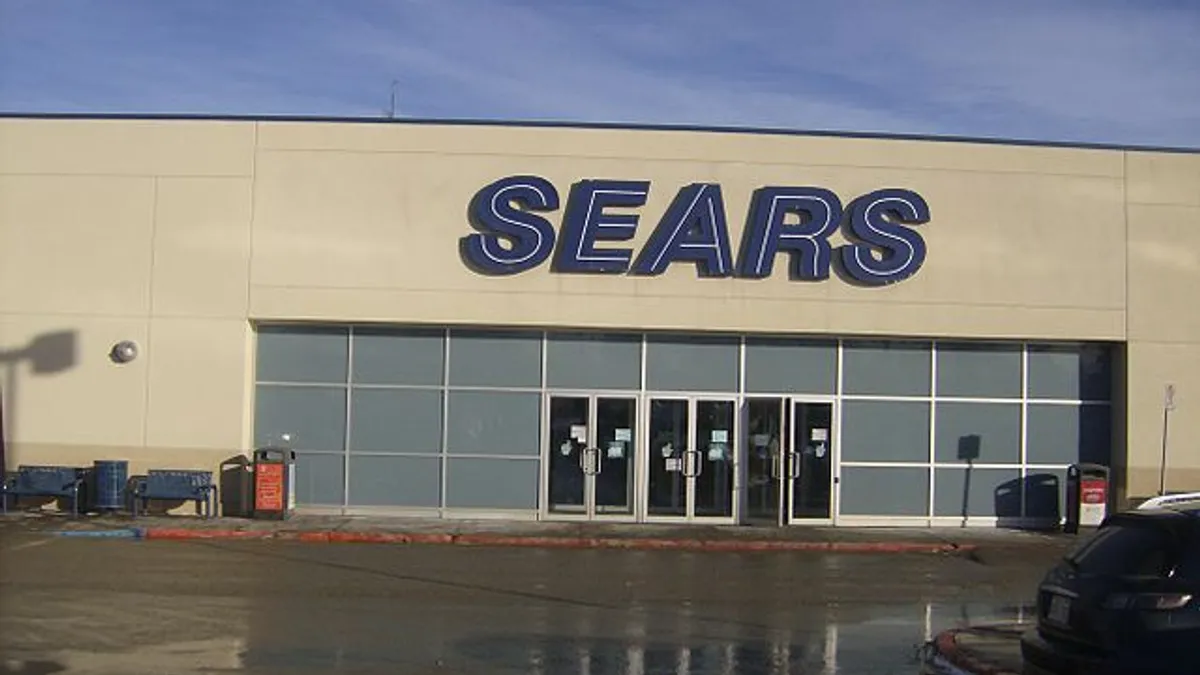Dive Brief:
-
Sears Holdings Corporation on Tuesday announced agreements that will help reduce its outstanding debt and pension obligations of $1.5 billion for fiscal 2017 by improving profitability, asset sales and working capital management, the company said in a press release.
-
On Monday, the company said that it will repay $100 million of its $500 million 2016 Secured Loan Facility at its original maturity in July 2017 but will extend the maturity on the remainder of the loan until January 2018, with the option to further extend that another six months to July 2018.
-
On May 15, 2017, Sears entered into an agreement to annuitize $515 million of pension liability with Metropolitan Life Insurance Company, which will pay future pension benefit payments to some 51,000 retirees.
Dive Insight:
Shrinking sales have made it that much harder for Sears to keep things afloat, and the company’s agreements to minimize its debt and pension obligations is yet another indication that its efforts are largely focused on its financial survival — to the detriment of retail fundamentals.
Sears Holdings CEO Eddie Lampert has been railing against many parties these days, with a particular focus on the news media, who he says have been unfairly painting the operator of Sears and Kmart stores as badly faltering.
By and large, the media is reporting facts and figures from analysts and the company's own financial disclosures and press releases. In December, Sears reported its 20th consecutive quarterly sales and revenue miss, and announced then it will accelerate the closing of unprofitable stores to combat declines. The company this year also sold its popular Craftsman tools line to Black & Decker for $900 million and has begun outsourcing its Kenmore home appliance brand.
In March, Sears expressed diminished hopes in its ability to continue operating, according to its annual report filing with the Securities and Exchange Commission. It wasn't a huge surprise when rumors (which were eventually confirmed) of massive layoffs at Sears’ corporate headquarters began circulating in February. Lampert eventually released a letter to employees, published by Business Insider, stating that 130 positions were eliminated and iterating much of what a spokesperson also later told Retail Dive.
While Lampert and Sears defend layoffs and other restructuring efforts as a sober path back to viability, in practice the moves have served to pay debt and stave off death. Rather than devising a plan to rebuild store traffic and drive growth (its much-touted and somewhat successful Shop Your Way omnichannel effort notwithstanding), Sears continues to rely on financial moves that merely prop it up — including loans from Lampert’s hedge fund, Greg Portell, lead partner in Retail Practice at consulting firm A.T. Kearney, told Retail Dive earlier this year.
“Successful transformations make some big cuts and some big moves, and growth reemerges. Here after three or four of those little cuts where they haven’t been able to get growth going, we start to lose faith,” Portell said. “There is certainly a place for financial reengineering. But when Sears goes back to it numerous times, it is an indicator they don’t have a real business solution.”
Confounding onlookers most is Sears’ desire to sell its prized possessions. In addition to unloading Craftsman, the company spun off its Lands’ End unit in 2014, and is shopping around its Kenmore, DieHard and Home Services business. The sale of Craftsman in particular “is a desperate move,” Walter Loeb, retail veteran and president of consulting firm Loeb Associates, wrote on discussion forum RetailWire earlier this year. “Selling iconic brands is devastating to the store. We are going to see a shrinking company with further losses.”













